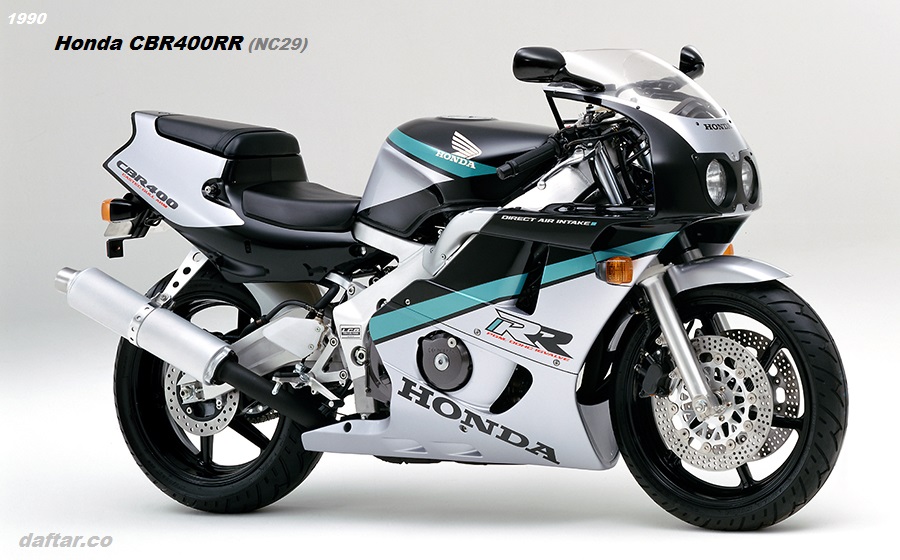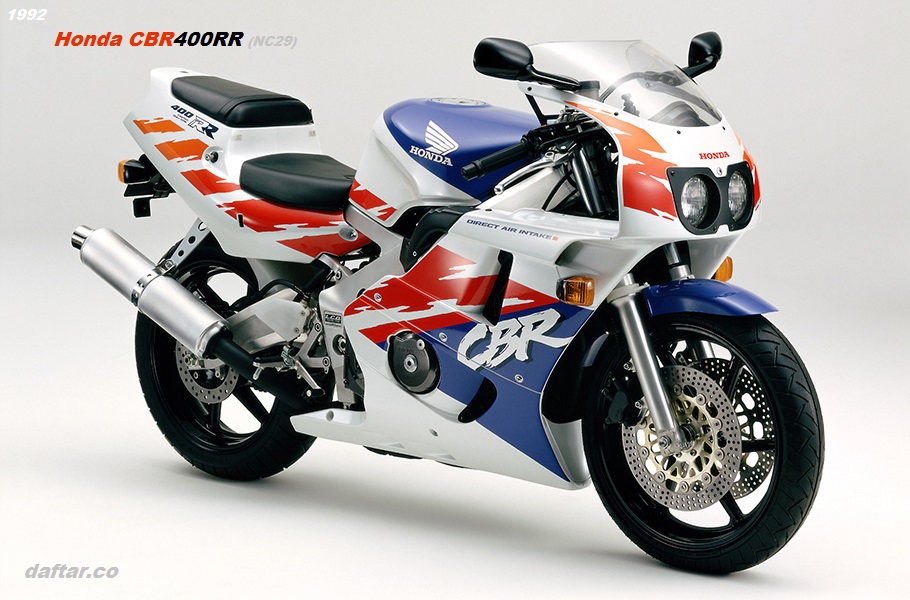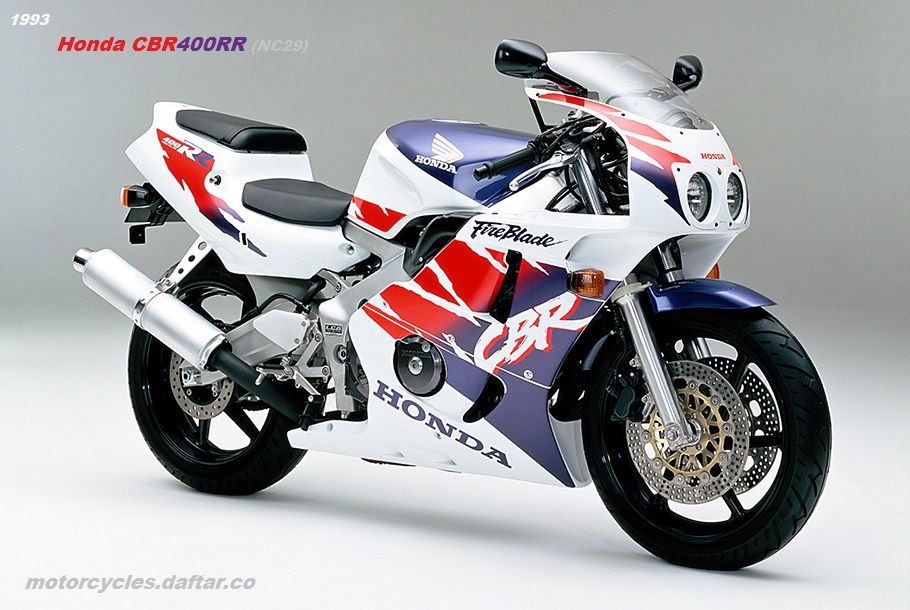“1990 Honda CBR400RR (Double R) NC29”, a super sports bike with an in-line 4-cylinder 400cc engine that demonstrates a Powerful and Straightforward Maneuvering Feeling.
 |
| Photo of 1990 Honda CBR400RR (NC29). Color: Black Silver. Release date : 1990-03-19. |
Honda CBR400RR is popular as a high-performance yet easy-to-use super sports bike equipped with Honda’s original cam gear train (a method of driving the camshaft with gears) mechanism, water-cooled, 4-stroke, DOHC, in-line 4-cylinder engine. This series was remodeled and released on March 19th, 1990. It looks more proper with better design and body works compared to the predessor (old CBR400RR 1st generation.
This 1990 Honda CBR400RR has “high-dimensional human fitting” as the development keyword, and in order to show a more straightforward ride to the rider’s operation (combined movement such as acceleration, deceleration, cornering), put a heavy object in the center of gravity of the car. In addition to bringing it closer, we thoroughly pursued the concentration of inertial mass (mass) by reducing the weight of the part far from the center of gravity, and the engine, frame, suspension, etc. are all newly designed.
The Honda CBR400RR’s engine has a completely new intake/exhaust system, such as arranging the air cleaner, carburetor, and intake port almost linearly. At the same time as improving efficiency, powerful torque characteristics and agile responsiveness are realized by adopting a map control type PGM ignition that can set and supply the optimum ignition timing according to the accelerator opening and engine speed. ing. In addition, the cylinder and upper/crankcase are integrated, and the main transmission shaft is located near the center of gravity to thoroughly pursue light weight, compactness, and mass concentration, which greatly contributes to improving the degree of freedom in frame design.
The frame and suspension are made of aluminum LCG (LOW CENTER OF GRAVITY, meaning low center of gravity) with a novel style newly designed according to the compact engine shape, and a lightweight and highly rigid large diameter (41 mm) front. -Forks, new-shaped aluminum rear forks (castec gull arm) that can efficiently lay out exhaust pipes while ensuring high rigidity, and lightweight 6-spoke aluminum wheels (front/rear) that reduce the amount of underspring. Equipped with a combination of 17-inch diameter). By centralizing the mass of the entire body and suspension and setting the center of gravity exquisitely, a maneuvering feeling that responds more honestly to the rider’s sensibility is realized.
In addition, a direct air intake that distributes the outside air in three directions is adopted, and in addition to the air cleaner and the rear of the engine, the outside air is also introduced to the rider’s knees, improving efficiency and comfort at the same time. ing. In addition, a storage space that allows one-touch opening and closing (hinge type) of the rear seat with a key operation, dual halogen headlights (60/3 5W x 2) with wider light distribution during low beam, and a loading hook. It is also equipped with equipment that improves usability, such as a retractable pillion step that can also be used.
1990 Honda CBR400RR Price
Sales plan (domestic/annual) : 14,000 units
Manufacturer’s suggested retail price of Honda CBR400RR at that year (1990): 699,000 yen.
(Vehicles equipped with speed warning lights are 10,000 yen higher).
(Hokkaido/Okinawa is 9,000 yen higher, excluding some other remote islands).
Honda CBR400RR Series Photos (Updated Model Year: 1990, 1991, 1992, 1993
 |
| 1992 Honda CBR400RR picture. Release date : 1992-04-07. |
This time, the body color is set to two colors, a tricolor (white / red / blue) color with a youthful and refreshing image that adopts a bold and dynamic brush pattern, and a black with a fearless and firm image. Combined with the “CBR” brush character logo on the side of the car body, the sportiness is further enhanced.
 |
| Image of 1993 Honda CBR400RR (NC29). Body Color: white. Stickers: Purple-blue, Red. Release date: 1993-12-15. |
Along with aging the super sports bike “Honda CBR400RR“, the coloring was changed and released. Looks more modern and neat.
1990 Honda CBR400RR Specifications
Manufacture’s original/standard main specs of Honda CBR400RR (NC29) 1990, 1991, 1992, 1993 :
| Common name | Honda CBR400RR | |
| Model | NC29 | |
| Overall length x Width x Height (m) | 1.990 x 0.670 x 1.080 | |
| Wheelbase (m) | 1.365 | |
| Minimum ground clearance (m) | 0.125 | |
| Seat height (m) | 0.750 | |
| Vehicle weight/Dry weight (kg) | 179/162 | |
| Riding capacity (persons) | 2 | |
| Fuel efficiency (km/L) 60km/h Constant driving test value | 35 | |
| Minimum turning radius (m) | 3.0 | |
| Engine model | NC23E (water-cooled, 4-cycle, DOHC, 4-valve, in-line 4-cylinder) | |
| Total displacement (cm3) | 399 | |
| Inner diameter x stroke (mm) | 55.0 x 42.0 | |
| compression ratio | 11.3 | |
| Maximum output (PS/rpm) | 59/13,000 | |
| Maximum torque (kgm/rpm) | 4.0/10,000 | |
| Carburetor model | VP01 | |
| Starting method | Self-type | |
| Ignition system type | Full transistor type (PGM ignition) battery ignition | |
| Lubrication method | Pressure-fed splash combination type | |
| Lubricating oil capacity (L) | 3.8 | |
| Fuel tank capacity (L) | 15 | |
| Clutch type | Wet multi-plate coil spring | |
| Transmission type | Always meshing 6-speed return | |
| Gear ratio | 1st speed | 3.307 |
| 2nd speed | 2.352 | |
| 3rd speed | 1.875 | |
| 4th speed | 1.590 | |
| 5th speed | 1.434 | |
| 6th speed | 1.318 | |
| Reduction ratio (1st/2nd) | 2.117/2.600 | |
| Caster (degree)/Trail (mm) | 24°30’/91 | |
| Tire size | Front | 120/60R17 55H |
| Rear | 150/60R17 66H | |
| Brake type | Front | Hydraulic double disc |
| Rear | Hydraulic disc | |
| Suspension method | Front | Telescopic method |
| Rear | Swing Arm (Castec Gull Arm) | |
| Frame format | backbone | |
This Honda CBR400RR has “high-dimensional human fitting” as the development keyword, and is popular for its excellent performance, such as demonstrating a more straightforward ride for rider operations (combined movements such as acceleration, deceleration, and cornering). It is a super sports model that has improved.